
Health in the Victorian period
Victorian healthcare was very different to today and mortality rates were very high. During the Victorian period the urban population grew very rapidly. New houses were built too quickly, too close together and without proper sewers or water supplies. Open sewers caused the spread of terrible diseases such as typhoid and cholera. These diseases killed thousands of people – in 1848 a cholera epidemic killed around 72,000 people across the country.
At the beginning of the Victorian period hospitals were very badly run and dirty. Over time the system got better and there were a number of medical breakthroughs. The biggest discovery was that of antiseptic, as operations could be carried out more safely. The development of anaesthetic meant that operations were a lot less painful for patients. Improved hygiene meant that fewer people died from infections.
Developments in science meant that Victorians began to understand why diseases developed and spread. A favourite Victorian saying was “Cleanliness if next to Godliness”.
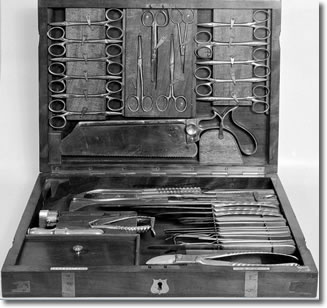
Surgeon’s case, c1900. Image courtesy of and copyright of Wellcome Collection, London. (Click image to enlarge.)
Health and medicine for the poor
Seeing a doctor or going to hospital, unlike today, was not free. Most poor people would not have been able to afford to get treated unless they were very sick. Often when poor Victorians were sick they went to the local chemist where they could buy medicine. One popular treatment for both rich and poor people was the use of leeches. The leeches were supposed to suck toxins from the blood of a sick person and make them better.

A selection of medical jars and a leech bowl. Copyright Beamish Museum.
Where large populations were living in overcrowded areas there was a high rate of disease and people became ill after being in contact with sewage and dirty drinking water. The health of people living in the slums began to improve a little after the Public Health Act of 1848. This Act made local councils responsible for building drains and providing clean water. By the end of the 19th century streets were being swept and cleaned regularly to prevent the build up of dirt. This helped to prevent the spread of disease.
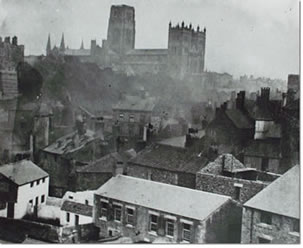
Photograph of late 19th or early 20th century housing in Durham city centre. (DUL ref Gibby A/CIT/92)
Health and medicine for the rich
Richer families lived in much cleaner and less crowded areas of the towns and cities. However, this not prevent families from falling ill. Wealthy families had a better standard of living as they could afford to eat a more balanced diet and did not have to work in dangerous industries such as mining. With more leisure time available they could engage in exercise and outdoor activities.

Photograph showing the back of No 7 North Bailey, a house occupied by a wealthy family in the Victorian period. DUL ref: Gibby Negatives B5. (Click image to enlarge.)
Families with more money could afford to pay for doctors and surgeons. In Durham these familes may have used the services of Mr Robson who lived on North Bailey with his family. The Census for 1881 records his occupation as a surgeon and general practitioner. It was obviously a family business as his son, Edward, is also listed as a surgeon and general practioner. The Robson’s lived in Durham for many years – they first appear on the 1851 Census and Mr Robson is still listed as a Surgeon in the 1901 Census!
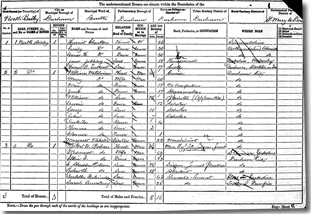
Extract from the 1881 Census showing the details of the Robson family. Courtesy of The National Archives, ref RG 11/4960 (Click image to enlarge.)
Death and funerals
In the Victorian period the funeral service was an important rite of passage. People often used it as an opportunity to display one’s wealth.
Many poorer people paid into burial clubs so that they would be able to pay for a proper funeral. If someone died and could not afford a proper burial they were given a pauper’s funeral meaning they would not have their own grave or headstone. This was seen as something shameful and to be avoided if at all possible.
In the Victorian period many people died in childhood. The Victorians believed that it was important to have babies baptised as early as possible so that if they died they would go to heaven.

Advert for a cab firm showing a horse-drawn hearse. From Durham: The Photographic Collection by Michael Richardson. (Click image to enlarge.)
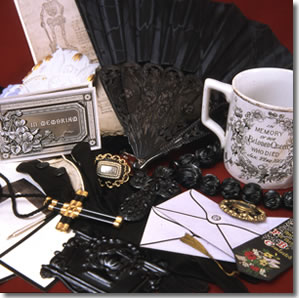
A selection of Victorian mourning objects. Copyright of York Museums Trust (York Castle Museum).
What did the Victorians eat?
Before the Industrial Revolution the majority of people worked on the land and many were able to grow some food for themselves. When they did buy food it came from local markets and shops. During the Industrial Revolution many people moved to towns and cities to work in the new factories. Many weekly markets disappeared due to demand for food in the towns.
Storing fresh food in the Victorian period was not easy so people had to go shopping much more often. The Victorians also had to a lot of different shops to buy their food – butchers, bakers, fishmongers, greengrocers etc. The closest shop that the Victorians had to a supermarket was the grocer.
Durham had a grocer’s shop called Greenwell’s. It was found in the city centre on a street called Silver Street and didn’t close until 1983. It’s owner, Mr Greenwell, lived on South Bailey.
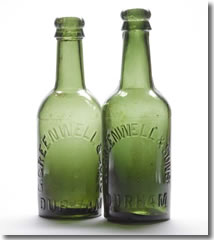
Photograph showing bottles from Greenwells. Image by Jeff Veitch, courtesy of Durham Heritage Centre.
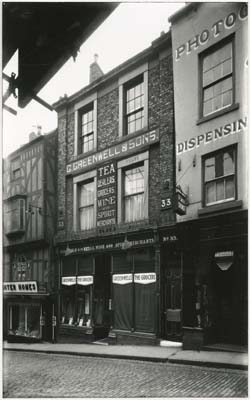
Photograph of Greenwell’s, the grocers shop in Durham. Image courtesy of Durham Heritage Cente.
What did the rich eat in Victorian Durham?
The Victorian who lived on the Baileys were mainly wealthy families who would have been able to afford a much better diet.
The meals for rich families were prepared and cooked by the servants in the kitchen. Food was cooked on a range and was served to the family in the dining room. Breakfast tended to be a large meal and would have included ham, eggs, bacon, bread and fish. This was followed by a light lunch and afternoon tea. The evening meal was the main meal of the day and had many different courses.
Wealthy Victorian families would often throw large dinner parties. These were extravagant affairs and servants would spend all day preparing the meal. It was fashionable to create elaborate dishes and use ice sculptures to decorate the table.
The Victorians were known for their desire to try new, exotic foods. This was helped by the expansion of the British Empire. Ingredients and local dishes were imported from countries such as India and China.
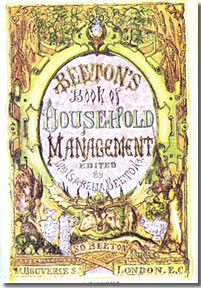
Front cover of Mrs Beeton’s Book of Household Management, first published in 1861. (Click image to enlarge.)

A selection of puddings taken from Mrs Beeton’s Book of Household Management. (Click image to enlarge.)
What did the poor eat?
A typical poor family living in a town would have had about 12 shillings to spend on food each week. A loaf of bread cost about 3 d (pennies). Most of the week’s money was spent on bread leaving little for other necessities. The weekly shop could also include milk, cheese and potatoes. Poor families could only afford meat once a week – this would have been saved for Sunday lunch.
Beer and gin were cheap, costing about 1d. Drink was also easier to get hold of than clean drinking water. This meant that many people drank alcohol instead and drunkeness was a problem in some areas.
Illness and death were common, especially in children. This was often due to poor diet and malnutrition although the biggest killer remained dirty drinking water.

A poor family preparing food. Image courtesy of www.eriding.net (Click image to enlarge.)